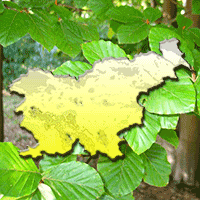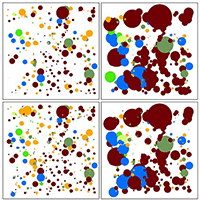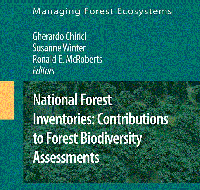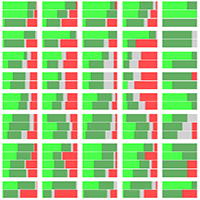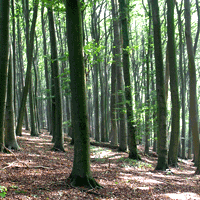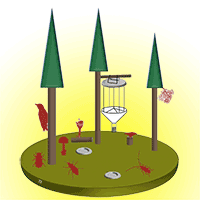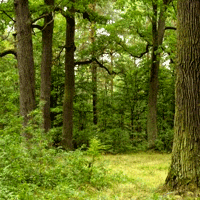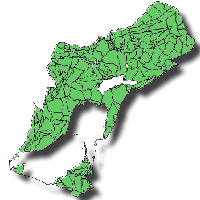
Towards cost-effective indicators to maintain Natura 2000 sites in favourable conservation status. Preliminary results from Cansiglio and New Forest
E Cantarello (1) , A Newton (2)
iForest - Biogeosciences and Forestry, Volume 1, Issue 1, Pages 75-80 (2008)
doi: https://doi.org/10.3832/ifor0410-0010075
Published: Feb 28, 2008 - Copyright © 2008 SISEF
Short Communications
Abstract
Natura 2000 is a coherent ecological network of special areas, designated under the Habitat and Birds EEC Directives, to assist in the maintenance of biodiversity in the European territory. It is now widely recognised that one of the most effective ways to maintain biodiversity is to preserve habitats in a favourable conservation status as required of Member States by the Habitat Directive. As a consequence, approaches are needed to define when habitats are of favourable conservation status and to assess the maintenance or the restoration of this condition. This could be partly achieved through the selection of appropriate indicators of favourable conservation status. Once such indicators have been identified and tested, they could be used for monitoring the impact of managing Natura 2000 sites, and could assist in achieving policy goals. Although many indicators have been proposed, particularly for forested habitats, few have been adequately field tested. Little research has been undertaken to identify indicators that are cost-effective, a key characteristic given that resources for habitat assessment and monitoring are often limited. Therefore, this research aims both to identify appropriate indicators to maintain favourable conservation status, and to evaluate their relative cost-effectiveness for two selected Natura 2000 sites: the Cansiglio Forest (North Italy) and the New Forest (South England). The following will highlight the results of the preliminary research.Natura 2000 is a coherent ecological network of special areas, designated under the Habitat and Birds EEC Directives, to assist in the maintenance of biodiversity in the European territory. It is now widely recognised that one of the most effective ways to maintain biodiversity is to preserve habitats in a favourable conservation status as required of Member States by the Habitat Directive. As a consequence, approaches are needed to define when habitats are of favourable conservation status and to assess the maintenance or the restoration of this condition. This could be partly achieved through the selection of appropriate indicators of favourable conservation status. Once such indicators have been identified and tested, they could be used for monitoring the impact of managing Natura 2000 sites, and could assist in achieving policy goals. Although many indicators have been proposed, particularly for forested habitats, few have been adequately field tested. Little research has been undertaken to identify indicators that are cost-effective, a key characteristic given that resources for habitat assessment and monitoring are often limited. Therefore, this research aims both to identify appropriate indicators to maintain favourable conservation status, and to evaluate their relative cost-effectiveness for two selected Natura 2000 sites: the Cansiglio Forest (North Italy) and the New Forest (South England). The following will highlight the results of the preliminary research.
Keywords
Authors’ Info
Authors’ address
Dipartimento Territorio e Sistemi Agro-Forestali, Università di Padova, viale dell’Università 16, 35020 Legnaro (PD - Italy)
School of Conservation Sciences, Bournemouth University, Talbot Campus Fern Barrow, Poole Dorset, BH12 5BB (United Kingdom)
Corresponding author
Paper Info
Citation
Cantarello E, Newton A (2008). Towards cost-effective indicators to maintain Natura 2000 sites in favourable conservation status. Preliminary results from Cansiglio and New Forest. iForest 1: 75-80. - doi: 10.3832/ifor0410-0010075
Paper history
Received: Jan 09, 2006
Accepted: Nov 06, 2006
First online: Feb 28, 2008
Publication Date: Feb 28, 2008
Publication Time: 15.97 months
Copyright Information
© SISEF - The Italian Society of Silviculture and Forest Ecology 2008
Open Access
This article is distributed under the terms of the Creative Commons Attribution-Non Commercial 4.0 International (https://creativecommons.org/licenses/by-nc/4.0/), which permits unrestricted use, distribution, and reproduction in any medium, provided you give appropriate credit to the original author(s) and the source, provide a link to the Creative Commons license, and indicate if changes were made.
Web Metrics
Breakdown by View Type
Article Usage
Total Article Views: 55477
(from publication date up to now)
Breakdown by View Type
HTML Page Views: 44638
Abstract Page Views: 3405
PDF Downloads: 6123
Citation/Reference Downloads: 72
XML Downloads: 1239
Web Metrics
Days since publication: 6492
Overall contacts: 55477
Avg. contacts per week: 59.82
Citation Metrics
Article Citations
Article citations are based on data periodically collected from the Clarivate Web of Science web site
(last update: Mar 2025)
Total number of cites (since 2008): 4
Average cites per year: 0.22
Publication Metrics
by Dimensions ©
Articles citing this article
List of the papers citing this article based on CrossRef Cited-by.
References
Selezione di indicatori ambientali per i temi relativi alla biosfera. RTI CTN_CON 1/2000.
Gscholar
Carta della Natura alla scala 1:50.000: metodologie di realizzazione. Manuali e Linee Guida 30/2004, Roma.
Gscholar
La gestione forestale nei SIC/ZPS della rete Natura 2000: chiavi di interpretazione e orientamenti per l’applicazione della direttiva Habitat. Monti e Boschi 2: 4-13.
Gscholar
Workshop on implementation of biodiversity monitoring requirements according requirements to the Habitats Directive in the EU Member States. 3-4 March, Sigulda, Latvia.
Gscholar
Integrating monitoring with Management Planning: a demonstration of good practice on Natura 2000 sites in Wales. Final Report - December 2000. In: Integrating monitoring with management plannning: a demonstration of good practice on Natura 2000 sites in Wales (CCW ed). Life-Nature Project No LIFE95 NAT/UK/ 000821 (available on CD-rom), CCW, Bangor.
Gscholar
Manuale AAA degli indicatori per la valutazione di impatto ambientale. Associazione Analisti Ambientali, Milano.
Gscholar
Un’esperienza di studio di tipologia forestale. Annali dell’Accademia Italiana di Scienze Forestali 41: 65-84.
Gscholar
Biodiversità e indicatori nei tipi forestali del Veneto. CD included. Commissione Europea, Accademia Italiana di Scienze Forestali, Direzione Regionale delle Foreste e dell’Economia Montana, Regione Veneto, Mestre, VE.
Gscholar
European significance of British woodland types. English Nature Report Number 460. English Nature, Peterborough.
Gscholar
Lowland heathland SSSIs: Guidance on conservation objectives setting and condition monitoring. Report Number 511. English Nature, Peterborough.
Gscholar
Managing Natura 2000 sites: the provisions of Article 6 of the “Habitats” Directive 92/43/EEC.
Gscholar
Interpretation Manual of European Union Habitat. EUR 25.
Gscholar
Natura 2000 and forests “challenges and opportunities”. Interpretation guide.
Gscholar
Note to the Habitat Committee. Assessment, monitoring and reporting of conservation status - Preparing the 2001-2007 report under Article 17 of the Habitats Directive (DocHab-04-03/03 rev.3).
Gscholar
International Conference on the Contribution of Criteria and Indicators for Sustainable Forest Management: the Way Forward (CICI-2003). Report. Guatemala City, 3-7 February 2003. FAO, Rome.
Gscholar
Foreste e biodiversità: principi e metodi di monitoraggio. Monti e Boschi 6: 5-21.
Gscholar
Common Standards Monitoring Guidance for Woodland Habitats. Version February 2004. JNCC, Peterborough.
Gscholar
Forest biodiversity indicators. Tools for policy-making and management. UNEP-WCMC, Cambridge.
Gscholar
Stand structure as the basis of diversity index. Forest Ecology and Management 115: 213-220.
Gscholar
Biodiversity evaluation tools for European forests. Ecological Bulletins 50. Wallin & Dalholm Press, Lund, Sweden.
Gscholar
Rete Natura 2000. Analisi dell’assetto forestale di un SIC. Sherwood 115: 23-29.
Gscholar
Piano ambientale per le riserve di Pian di Landro Baldassarre e Piaie Longhe - Millifret. Veneto Agricoltura, unpublished work.
Gscholar
Improved Pan-European Indicators for Sustainable Forest Management as adopted by the MCPFE Expert Level Meeting 7-8 October 2002. Wien, Austria.
Gscholar
Estimation of population density by spacing method. Memoirs of the Faculty of Science Kyushu University, Series E 1: 187-197.
Gscholar
Terrestrial vegetation monitoring protocols. Eman Occasional Paper Series, Report 9. Canada Centre for Inland Waters, Burlington, Ontario, Canada.
Gscholar
Testing criteria and indicators for the sustainable management of forests: phase 1. Final report CIFOR. Jakarta, Indonesia.
Gscholar
Gli indicatori ambientali. Valori, metri, e strumenti nello studio di impatto ambiemtale. Franco Angeli, Milano.
Gscholar
Monitoring the condition and biodiversity status of European Conservation Sites. A discussion paper. Final Draft. Report to the EEA on the behalf of the ETC/NC, Paris.
Gscholar
A new type pf sample unit for the efficient assessment of diverse tree communities in complex forest landscapes. Journal of Tropical Forest Science 15: 117-135.
Gscholar
Why be wasteful when preserving a valuable resource? A review article on the cost-effectiveness of European biodiversity conservation policy. Biological Conservation 123: 327-338.
Gscholar


